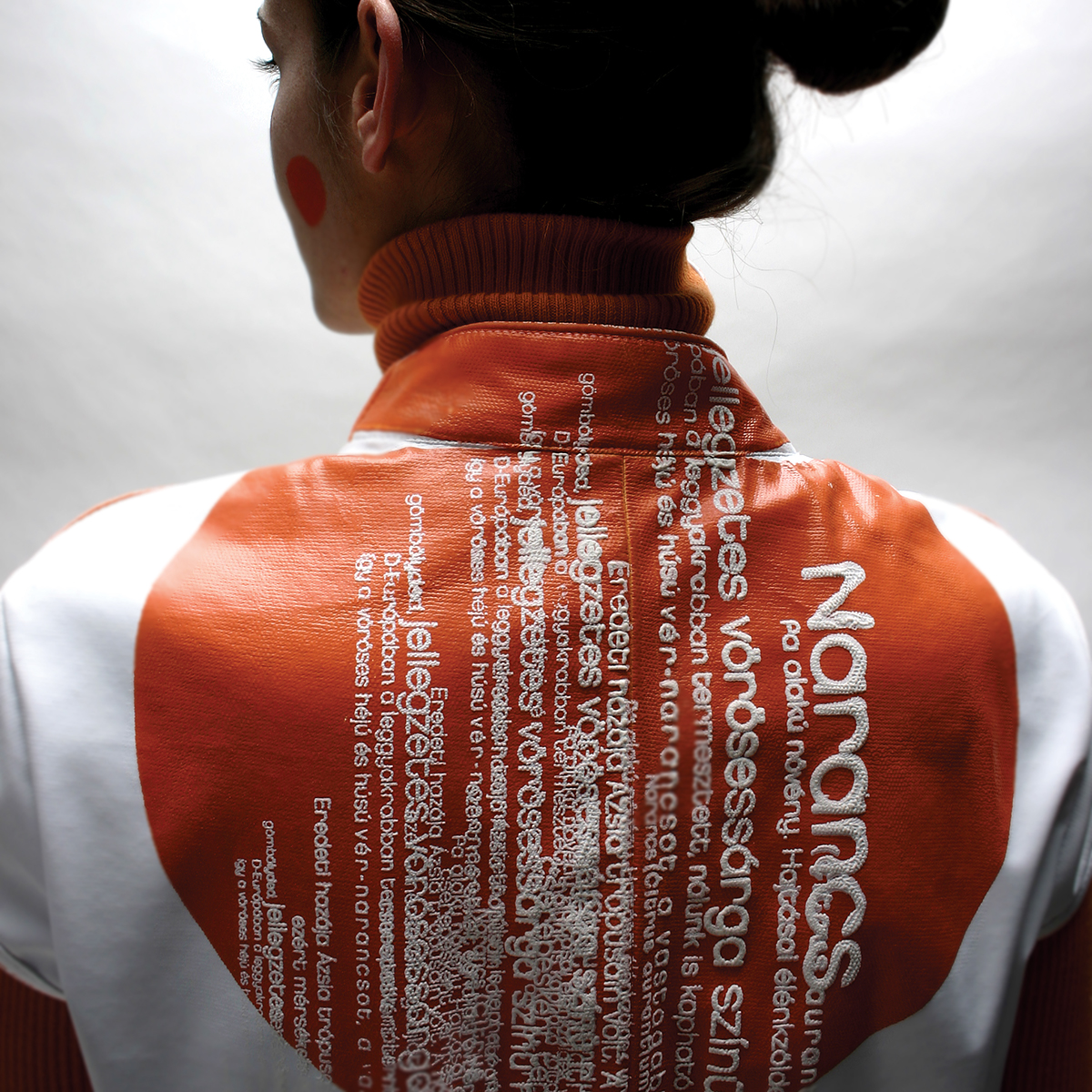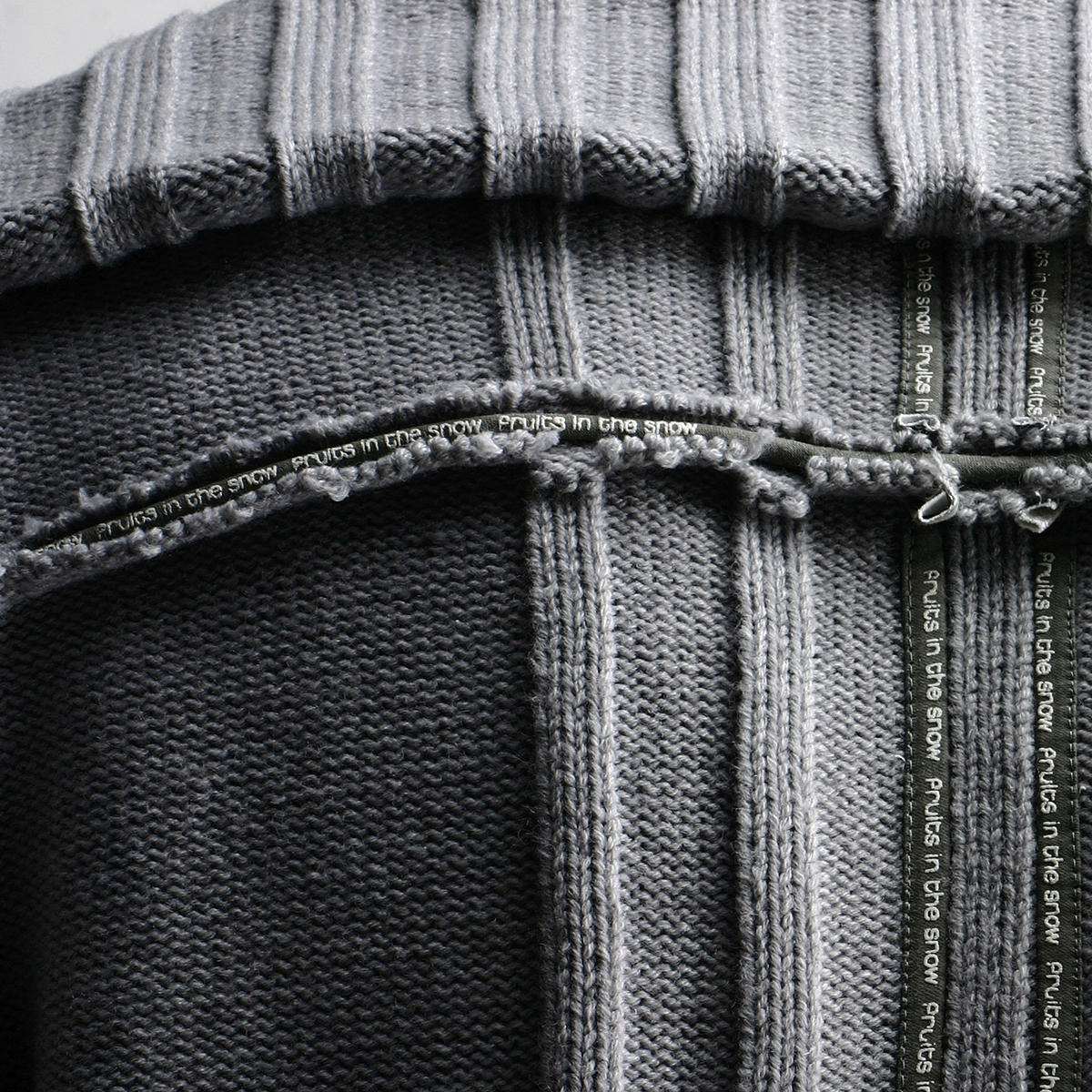
project: f r u i t in t h e s n o w k n i t t e d collection - FR.I.S
01: the man and the lemon - a férfi és a citrom:
The lemon (Citrus × limon) is a hybrid in cultivated wild plants. It is the common name for the reproductive tissue surrounding the seed of the angiosperm lemon tree. The lemon is used for culinary and nonculinary purposes throughout the world. The fruit is used primarily for its juice, though the pulp and rind (zest) are also used, primarily in cooking and baking. Lemon juice is about 5% (approximately 0.03 moles/Liter) citric acid, which gives lemons a tart taste, and a pH of 2 to 3. This makes lemon juice an inexpensive, readily available acid for use in educational science experiments. The exact origin of the lemon has remained a mystery, though it is widely presumed that lemons are wildly grown in both India and China.[1][2]It is also speculated that lemons were first grown on Mediterraneanbushes, coined lemon bushes, but they have evolved and modern-daylemons grow on trees. In the Far East, it was known for its antisepticproperties and it was used as antidote for various poisons. The lemonwas later introduced to Iraq and Egypt around 700 A.D. The popular drink lemonade may have originated in medieval Egypt.[1] It was distributed widely throughout the Arab world and the Mediterranean region between 1000 A.D. to 1150 A.D. At this time, the lemon was first recorded in literatures to a tenth century Arabic treatise on farming and was used as an ornamental plant in early Islamic gardens.[1][2] The lemon is in fact man made. Limeswere specially cultivated in the late 12th century, to be bigger, atthe compromise of not being quite as acidic as the common lime.[citation needed] Lemons entered Europe (near southern Italy) no later than the firstcentury AD, during the time of Ancient Rome. However, they were notwidely cultivated. The first real lemon cultivation in Europe began in Genoa in the middle of the fifteenth century.[2] It was later introduced to the Americas in 1493 when Christopher Columbusbrought lemon seeds to Hispaniola along his voyages. Spanish conquestthroughout the New World helped spread lemon seeds. It was mainly usedas ornament and medicine.[2] In 1700s and late 1800s, lemons were increasingly planted in Florida and California when lemons began to be used in cooking and flavoring.[3] In 1747, James Lind's experiments on seamen suffering from scurvy involved adding Vitamin C to their diets through lemon juice. [4]The name lemon was originated from Arabic līmūn لی�...ون and Persian limun through Old Italian and Old French limone.
01: the man and the lemon - a férfi és a citrom:
The lemon (Citrus × limon) is a hybrid in cultivated wild plants. It is the common name for the reproductive tissue surrounding the seed of the angiosperm lemon tree. The lemon is used for culinary and nonculinary purposes throughout the world. The fruit is used primarily for its juice, though the pulp and rind (zest) are also used, primarily in cooking and baking. Lemon juice is about 5% (approximately 0.03 moles/Liter) citric acid, which gives lemons a tart taste, and a pH of 2 to 3. This makes lemon juice an inexpensive, readily available acid for use in educational science experiments. The exact origin of the lemon has remained a mystery, though it is widely presumed that lemons are wildly grown in both India and China.[1][2]It is also speculated that lemons were first grown on Mediterraneanbushes, coined lemon bushes, but they have evolved and modern-daylemons grow on trees. In the Far East, it was known for its antisepticproperties and it was used as antidote for various poisons. The lemonwas later introduced to Iraq and Egypt around 700 A.D. The popular drink lemonade may have originated in medieval Egypt.[1] It was distributed widely throughout the Arab world and the Mediterranean region between 1000 A.D. to 1150 A.D. At this time, the lemon was first recorded in literatures to a tenth century Arabic treatise on farming and was used as an ornamental plant in early Islamic gardens.[1][2] The lemon is in fact man made. Limeswere specially cultivated in the late 12th century, to be bigger, atthe compromise of not being quite as acidic as the common lime.[citation needed] Lemons entered Europe (near southern Italy) no later than the firstcentury AD, during the time of Ancient Rome. However, they were notwidely cultivated. The first real lemon cultivation in Europe began in Genoa in the middle of the fifteenth century.[2] It was later introduced to the Americas in 1493 when Christopher Columbusbrought lemon seeds to Hispaniola along his voyages. Spanish conquestthroughout the New World helped spread lemon seeds. It was mainly usedas ornament and medicine.[2] In 1700s and late 1800s, lemons were increasingly planted in Florida and California when lemons began to be used in cooking and flavoring.[3] In 1747, James Lind's experiments on seamen suffering from scurvy involved adding Vitamin C to their diets through lemon juice. [4]The name lemon was originated from Arabic līmūn لی�...ون and Persian limun through Old Italian and Old French limone.

project: f r u i t in t h e s n o w k n i t t e d collection - FR.I.S
02: the grapes - a szölö:
Grapes grow in clusters of 6 to 300, and can be crimson, black, darkblue, yellow, green and pink. However, "white" grapes are actuallygreen in color, and are evolutionarily derived from the red grape.Mutations in two regulatory genes of white grapes turn off productionof anthocyanins which are responsible for the color of red grapes.[1] Anthocyanins and other pigmentpolyphenols in red grapes are responsible for the varying shades of purple in red wines.[2][3] Most grapes come from cultivars of chemicals of the larger family of Vitis vinifera,the European grapevine native to the Mediterranean and Central Asia.Minor amounts of fruit and wine come from American and Asian speciessuch as: Vitis labrusca, the North American table and grape juice grapevines (including the concord cultivar), sometimes used for wine. Native to the Eastern United States and Canada. Vitis riparia, a wild vine of North America, sometimes used for winemaking and for jam. Native to the entire Eastern U.S. and north to Quebec. Vitis rotundifolia, the muscadines, used for jams and wine. Native to the Southeastern United States from Delaware to the Gulf of Mexico.Vitis vulpina Frost grape. Native to the United States Midwest east to the coast up through New York. Vitis amurensis Most important Asian species. The sea grape Coccoloba uvifera is actually a member of the Buckwheat family Polygonaceae and is native to the islands of the Caribbean Sea. According to the Food and Agriculture Organization(FAO), 75,866 square kilometres of the world are dedicated to grapes.Approximately 71% of world grape production is used for wine, 27% asfresh fruit, and 2% as dried fruit.A portion of grape production goes to producing grape juice to bereconstituted for fruits canned "with no added sugar" and "100%natural". The area dedicated to vineyards is increasing by about 2% peryear.
02: the grapes - a szölö:
Grapes grow in clusters of 6 to 300, and can be crimson, black, darkblue, yellow, green and pink. However, "white" grapes are actuallygreen in color, and are evolutionarily derived from the red grape.Mutations in two regulatory genes of white grapes turn off productionof anthocyanins which are responsible for the color of red grapes.[1] Anthocyanins and other pigmentpolyphenols in red grapes are responsible for the varying shades of purple in red wines.[2][3] Most grapes come from cultivars of chemicals of the larger family of Vitis vinifera,the European grapevine native to the Mediterranean and Central Asia.Minor amounts of fruit and wine come from American and Asian speciessuch as: Vitis labrusca, the North American table and grape juice grapevines (including the concord cultivar), sometimes used for wine. Native to the Eastern United States and Canada. Vitis riparia, a wild vine of North America, sometimes used for winemaking and for jam. Native to the entire Eastern U.S. and north to Quebec. Vitis rotundifolia, the muscadines, used for jams and wine. Native to the Southeastern United States from Delaware to the Gulf of Mexico.Vitis vulpina Frost grape. Native to the United States Midwest east to the coast up through New York. Vitis amurensis Most important Asian species. The sea grape Coccoloba uvifera is actually a member of the Buckwheat family Polygonaceae and is native to the islands of the Caribbean Sea. According to the Food and Agriculture Organization(FAO), 75,866 square kilometres of the world are dedicated to grapes.Approximately 71% of world grape production is used for wine, 27% asfresh fruit, and 2% as dried fruit.A portion of grape production goes to producing grape juice to bereconstituted for fruits canned "with no added sugar" and "100%natural". The area dedicated to vineyards is increasing by about 2% peryear.

project: f r u i t in t h e s n o w k n i t t e d collection - FR.I.S
03: the orange the raspberry and the blueberry - a narancs az áfonya és a málna:
An orange�"specifically, the sweet orange�"is the citrus fruit Citrus sinensis (syn. Citrus aurantium L. var. dulcis L., or Citrus aurantium Risso) and its fruit. The orange is a hybrid of ancient cultivated origin, possibly between pomelo (Citrus maxima) and tangerine (Citrus reticulata). It is a small flowering tree growing to about 10 m tall with evergreen leaves, which are arranged alternately, of ovate shape with crenulate margins and 4�"10 cm long. The orange fruit is a hesperidium, a type of berry. Oranges originated in Southeast Asia. The fruit of Citrus sinensis is called sweet orange to distinguish it from Citrus aurantium, the bitter orange. In a number of languages, it is known as a "Chinese apple" (e.g. Dutch Sinaasappel, "China's apple", or "Apfelsine" in German). The name is thought to ultimately derive from the Dravidian word for the orange tree, with its final form developing after passing through numerous intermediate languages.
Blueberries are flowering plants in the genus Vaccinium, sect. Cyanococcus. The species are native only to North America. They are shrubsvarying in size from 10 cm tall to 4 m tall; the smaller species areknown as "lowbush blueberries", and the larger species as "highbushblueberries". The leaves can be either deciduous or evergreen, ovate to lanceolate, and from 1-8 cm long and 0.5-3.5 cm broad. The flowers are bell-shaped, white, pale pink or red, sometimes tinged greenish.The fruit is a false berry5-16 mm diameter with a flared "crown" at the end; they are palegreenish at first, then reddish-purple, and finally indigo on ripening.They have a sweet taste when mature, with variable acidity. Blueberrybushes typically bear fruit from May through October in the NorthernHemisphere; "blueberry season" peaks in July, which is NationalBlueberry Month in the United States and Canada.[1]All species whose English common names include "blueberry" are currently classified in section Cyanococcus of the genus Vaccinium. Several other plants of the genus Vaccinium also produce blue berries which are sometimes confused with blueberries, mainly the predominantly European bilberry (Vaccinium myrtillus), which in many languages has a name that means "blueberry" in English. See the Identification section for more information.Although blueberries are native to North America, they are now grownalso in the Southern Hemisphere in Australia, New Zealand and SouthAmerican countries[2], and are air-shipped as fresh produce to markets around the world.Beginning in 2005, blueberries have been discussed among a category of functional foods called superfruits having the favorable combination of nutrient richness, antioxidant strength, emerging research evidence for health benefits[2] and versatility for manufacturing popular consumer products.[3][4]
The raspberry (plural, raspberries) is the edible fruit of a number of plant species in the subgenus Idaeobatus of the genus Rubus; the name also applies to these plants themselves. The name originally referred to the European species Rubus idaeus, with red fruit, and is still used for that species as its standard English name in its native area.[1] Several other species, mostly closely related in the same subgenus Idaeobatus, are now also called raspberries. Raspberries are an important commercial fruit crop, widely grown in alltemperate regions of the world. Many of the most important moderncommercial red raspberry cultivars derive from hybrids between R. idaeus and R. strigosus.[2] Some botanists consider the Eurasian and American red raspberries to all belong to a single, circumboreal species, Rubus idaeus, with the European plants then classified as either R. idaeus subsp. idaeus or R. idaeus var. idaeus, and the native North American red raspberries classified as either R. idaeus subsp. strigosus, or R. idaeus var. strigosus.
03: the orange the raspberry and the blueberry - a narancs az áfonya és a málna:
An orange�"specifically, the sweet orange�"is the citrus fruit Citrus sinensis (syn. Citrus aurantium L. var. dulcis L., or Citrus aurantium Risso) and its fruit. The orange is a hybrid of ancient cultivated origin, possibly between pomelo (Citrus maxima) and tangerine (Citrus reticulata). It is a small flowering tree growing to about 10 m tall with evergreen leaves, which are arranged alternately, of ovate shape with crenulate margins and 4�"10 cm long. The orange fruit is a hesperidium, a type of berry. Oranges originated in Southeast Asia. The fruit of Citrus sinensis is called sweet orange to distinguish it from Citrus aurantium, the bitter orange. In a number of languages, it is known as a "Chinese apple" (e.g. Dutch Sinaasappel, "China's apple", or "Apfelsine" in German). The name is thought to ultimately derive from the Dravidian word for the orange tree, with its final form developing after passing through numerous intermediate languages.
Blueberries are flowering plants in the genus Vaccinium, sect. Cyanococcus. The species are native only to North America. They are shrubsvarying in size from 10 cm tall to 4 m tall; the smaller species areknown as "lowbush blueberries", and the larger species as "highbushblueberries". The leaves can be either deciduous or evergreen, ovate to lanceolate, and from 1-8 cm long and 0.5-3.5 cm broad. The flowers are bell-shaped, white, pale pink or red, sometimes tinged greenish.The fruit is a false berry5-16 mm diameter with a flared "crown" at the end; they are palegreenish at first, then reddish-purple, and finally indigo on ripening.They have a sweet taste when mature, with variable acidity. Blueberrybushes typically bear fruit from May through October in the NorthernHemisphere; "blueberry season" peaks in July, which is NationalBlueberry Month in the United States and Canada.[1]All species whose English common names include "blueberry" are currently classified in section Cyanococcus of the genus Vaccinium. Several other plants of the genus Vaccinium also produce blue berries which are sometimes confused with blueberries, mainly the predominantly European bilberry (Vaccinium myrtillus), which in many languages has a name that means "blueberry" in English. See the Identification section for more information.Although blueberries are native to North America, they are now grownalso in the Southern Hemisphere in Australia, New Zealand and SouthAmerican countries[2], and are air-shipped as fresh produce to markets around the world.Beginning in 2005, blueberries have been discussed among a category of functional foods called superfruits having the favorable combination of nutrient richness, antioxidant strength, emerging research evidence for health benefits[2] and versatility for manufacturing popular consumer products.[3][4]
The raspberry (plural, raspberries) is the edible fruit of a number of plant species in the subgenus Idaeobatus of the genus Rubus; the name also applies to these plants themselves. The name originally referred to the European species Rubus idaeus, with red fruit, and is still used for that species as its standard English name in its native area.[1] Several other species, mostly closely related in the same subgenus Idaeobatus, are now also called raspberries. Raspberries are an important commercial fruit crop, widely grown in alltemperate regions of the world. Many of the most important moderncommercial red raspberry cultivars derive from hybrids between R. idaeus and R. strigosus.[2] Some botanists consider the Eurasian and American red raspberries to all belong to a single, circumboreal species, Rubus idaeus, with the European plants then classified as either R. idaeus subsp. idaeus or R. idaeus var. idaeus, and the native North American red raspberries classified as either R. idaeus subsp. strigosus, or R. idaeus var. strigosus.
















